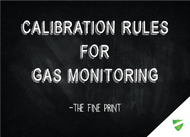Gas Monitor Calibration
When it comes to calibrating and using gas monitors to detect hazardous gases, you really need to do three things:
1. Calibrate your gas monitor
2. Bump test it before each use
3. Document your testing activities
Calibration and maintenance of gas detectors is essential for the safety of workers who may be exposed to hazardous gases or atmospheres. Regular calibration and maintenance helps to make sure that your gas monitors are doing what they are designed to - prevent serious injuries or illnesses, property damage, or even death.
In fact, OSHA recommends developing standard procedures that include documenting the proper maintenance and calibration of the instruments.
Need a gas calibration log for that purpose? We've got you covered. Just scroll down to the bottom of this article to download your free log sheet right now.
So why the need to conduct regular maintenance and calibration on your instrumentation?
Calibration and maintenance of gas detectors is necessary to keep you safe! Failure to make sure your instrumentation is accurate can lead to exposure to toxic gases like carbon monoxide or to an atmosphere lacking oxygen.
Let's just say, "no bueno!"
Exposure to these kind of environments are super dangerous and can lead to serious injuries or illness, and even death. Combustible gas explosions are often catastrophic, resulting in worker injuries and death, or destruction of property. With the proper maintenance and use of a handheld gas monitors, safety hazards of that nature can be prevented.
Introducing the "Bump Test"
The best way to make sure that a multi gas meter will detect toxic gas is to expose it to a known concentration of gas that will trigger its alarm. This procedure is known as a "bump test" and will tell you if the sensors in the instrument are providing accurate reading and whether the alarm works.
The International Safety Equipment Association recommends testing your gas detection instruments before each day's use.
The following are a few basic calibration rules for gas monitors:
- Follow the manufacturer's guidelines for proper calibration. You can't perform any job, including DRPGM calibration, properly or safely without the right tools. The type and concentration of calibration gas used for testing, sample tubing, flow regulators, and calibration adapters are key links in the calibration chain. You should also always test your gas monitor gas monitor in an environment that is identical or similar to your working conditions (e.g., temperature, humidity, atmospheric pressure).
- Only use a certified traceable test gas before they expire. Accuracy of the instrument depends on calibration test-gas. Always obtain a certificate of analysis for each cylinder.
- Reactive gases like H2S and Cl2 are only stable for a short time, and must not be used beyond their expiration date. Never use a test gas after its expiration date.
- Train users on the proper methods of gas monitor calibration. Most instruments are designed to be field calibrated or you can bring them in for calibration services by an expert technician like us. Employers should train and test everyone responsible for performing DRPGM calibration.
When should you service your multi-gas monitor?
Calibration - Before first use and one a month.
Bump Test - Prior to each day’s use.
Keep in mind a calibration should be performed immediately following any of these incidents:
- the unit falls,
- is dropped, or experiences another significant impact;
- is exposed to water;
- fails a bump test; or
- has been repeatedly exposed to an over-range (positive or negative) gas concentration.
Calibration service is also recommended after the installation of a new (or replacement) sensor. Using faulty portable gas monitors is not something you want to fiddle with.
Don't just take our word for it, these recommendations are based on field data, safe work procedures, industry best practices, and regulatory standards to ensure worker safety.
Need help calibrating your gas monitor? Safety Services, Inc. offers 4 gas monitor calibration services for instrumentation by Honeywell BW, MSA, GFG, and Industrial Scientific!
Overall, regular maintenance and calibration of gas monitors is essential for ensuring the safety of workers and preventing accidents and injuries. If you follow the guidelines outlined above, you can have peace of mind that your gas monitors are providing accurate readings and functioning properly.
Learn more about our instrument calibration services here.
Download Free Calibration Log Sheet
Calibration Questions? Contact Us Today!

